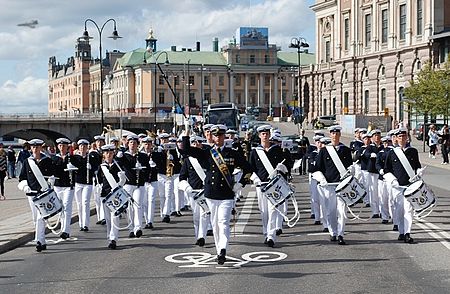- Royal Swedish Navy Cadet Band
-
The Royal Swedish Navy Cadet Band is a military band that was created in 2002 in cooperation with the Swedish Armed Forces Music Centre and the Royal Swedish Navy Band. The RSwNCB is the only young band in Sweden which has been approved for the Changing of the Royal Guards at the Royal Palace in Stockholm.
The band has a close contact with the Royal Swedish Navy Band.
The RSwNCB consists of about 70 young musicians in the ages 14 to 23 years. The band is based in Karlskrona in the south-east of Sweden. The musicians come from all of Sweden, but the south is especially well represented. The band works in project form and rehearses one weekend per month which results in one or several performances.
The primary goal for the RSwNCB is to safeguard and develop the Swedish military music in general and the Swedish naval music in particular. This is achieved by using the Ship-cadet corps uniforms and hence keeping their traditions since 1685. Another goal is to be a base for recruiting for the other military bands in Sweden, the Central Band of the Swedish Army, the Royal Swedish Navy Band and the Swedish Mounted Band of the Royal Lifeguards.
Contents
Major performances
The Royal Swedish Navy Cadet Band at the changing of the guard at Stockholm Palace, Sweden, in July 2011.
The RSwNCB has participated in the following military tattoos and music festivals:
- 2004: Swedish Military Tattoo
- 2005: Ystad International Military Tattoo
- 2006: Swedish Military Tattoo, Eksjö Tattoo
- 2008: Eksjö Tattoo, Musikparade der Nationen in Hannover
- 2009: Musikschau der Nationen in Bremen, Fulda Military Tattoo, Polizeishow Hamburg
- 2010: Musikparade Germany in Frankfurt, Stuttgart, Erfurt and Munich, Birmingham Military Tattoo
- 2011: Musikparade Germany in Rostock, Cottbus and Schwerin,Sweden International Tattoo in Malmö Arena, Malmö
- 2012: The band has been selected to perform in the 2012 New Year's Day Rose Parade in Pasadena, California on January 2, 2012.
The band has also participated in three Changing of the Guard ceremonies at the Royal Castle in Stockholm. The band was the first youth band (ages 15–25) to participate in this ceremony.
The RSwNCB participated in the cortege at the Wedding of Victoria, Crown Princess of Sweden, and Daniel Westling on 19 June 2010.
The First Drummer or Drum Major
The First Drummer, Drum Major, or flaggtrumslagare is the leader of the band during marching. The first drummer also has responsibility for the marching quality of the band, as well as responsibility for composing figurative shows for performances. The first drummer does not carry a drum; the title is better understood as the leader of the drummers (and as such of the band). The sign of command of the first drummer is the ceremonial mace or stav, although by tradition, an ornate drum strap is carried across the shoulder as well.
The Sergeant Major of the Drums or drum major is the leader of a marching band, drum or bugle corps, or pipe band. The Drum Major is usually positioned at the head of the Band or Corps and is the figure who stands out in the public eye. The Drum Major is responsible for providing commands either verbally, through hand gestures, or with a mace in the military or with whistle commands or a baton in the US civilian bands to the ensemble regarding where to march, what to play, and what time to keep. They are often dressed in more ornate clothing than the rest of the Band or Corps.
The Drum Major of the RSwNCB is by tradition also a musician in the band hence plays his/her instrument at indoor concerts.
List of Drum Majors of the RSwNCB
- Johan Förberg 2010-
- Johan Welander 2004-2005, 2009
- Martin Arpåker 2008
- John Sigurdsson 2006-2007
- Niklas Holtne 2002-2004
Uniform
Uniform Modell 1930
The uniform of the Royal Swedish Navy Cadet Band has its own unique story which begins in the early days of the naval city Karlskrona and the Ship-cadet corps.
The ship-cadet corps was a group of youth who were taught sailing and other maritime skills aboard the large sailing ships in Sweden. The history of the ship-cadet corps began in 1685 and the corps with its musical performances was decommissioned in 1939. The corps had companies in Karlskrona, Stockholm and Marstrand.
The uniform was often quite simple. The trousers were sometimes sewn from sail cloth and could therefore be quite roomy. Under the collar, a scarf or råbandshalsduk was worn. Two of the things which have been kept through history are the emblem on the cap and the ribbon for the cap (topplänta). The emblem is an anchor, mirrored with respect to the one in use by other maritime bodies. The ribbon was used during climbs in the masts, fastened under the chin. It became tradition that the ribbon be fastened during parades ashore as well, a tradition that the Royal Swedish Navy Cadet Band keeps alive to this day.
Records
Avanti per Patria! is the latest record by the Royal Swedish Navy Cadet Band. The record features many famous marches from Sweden as well a several international greats. The record was produced by the Blekinge Institute of Technology, BTH.
Gallery
References
- The Royal Swedish Navy Band (in swedish)
- Musikparade der Nationen, Hannover (in german)
- Bleking Läns Tidning (swedish newspaper)
- Norra Skåne (swedish newspaper)
- Smålandsposten (swedish newspaper)
External links
- Source: Official homepage
- Source: The Swedish Armed Forces Music Centre
Categories:- Military bands
- Wind bands
- Musical groups established in 2002
- Swedish musical groups
Wikimedia Foundation. 2010.





